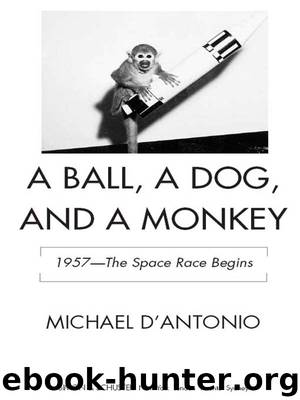A Ball, A Dog, and A Monkey by Michael D’Antonio

Author:Michael D’Antonio
Language: eng
Format: epub
Publisher: Simon and Schuster
Published: 2007-07-15T00:00:00+00:00
At seventy feet, Juno was just half as tall as the Statue of Liberty without its base, and for more than ten days she had cast a shadow over the efforts of the Vanguard missileers, standing watch over their struggle and failure. It was hard for them to escape feeling intimidated, especially when they considered that Juno’s old technology was also the most reliable around. Years later, Vanguard engineer Kurt Stehling would still describe the rocket as if he was talking about a human rival who “stood nearby, almost insolent, backed by a good history of testing and an eager staff of experienced missile engineers.”
The Juno team’s experience showed, even when it came to bureaucratic gamesmanship on the Cape. In talks with missile range commander Donald Yates, Medaris managed to win a guarantee that his team would have extended and exclusive support for a launch once Vanguard scrubbed. The Army would have no competition for services until Juno flew, or the launch was canceled.
In response to President Eisenhower’s frustration over the public humiliation that came with TV-3’s demise, Yates also set up the kind of press arrangements that would guarantee worldwide publicity for the satellite launch under conditions that were so well controlled they would please even the most paranoid image-maker. Yates was a friendly, small-town fellow from Maine with a bright, toothy smile. His charm helped him to keep the press in line, but when it failed him, he only had to remind reporters that he controlled all the things that they wanted: accurate information about missions, access to the launch pad area, and knowledge of launch schedule.
According to the Yates plan, which Time magazine dubbed “peacetime censorship,” reporters and photographers would be alerted hours ahead of time and bused to the test area where the view, a little more than a mile from the launch pads, was far better than it was at the beach. There they would be tended by press officer Ken Grine, and would receive extensive background briefings and printed materials filled with accurate information.
Grine was perfect for this job. A space enthusiast and career military man, he would protect the image of the space pioneers. But he also liked journalists and wanted to help them. “They were pushy, but they had to be,” he recalled. “Getting them out to the Cape solved a lot of their problems, but it created others.”
The main problem was isolation. In exchange for their special access, the journalists at the launch site had to agree to keep silent until after Juno was fired or retired. In this age before wireless communication, Grine controlled the phones in the wooden booths at their viewing area, which was built atop a structure called the Optics Building. The phones wouldn’t be turned on and available for reports until after Juno was fired and everyone involved was ready for the news to go out.
With the news media corraled and an experienced team following an established routine to launch a reliable rocket, everything that could be controlled was.
Download
This site does not store any files on its server. We only index and link to content provided by other sites. Please contact the content providers to delete copyright contents if any and email us, we'll remove relevant links or contents immediately.
| Automotive | Engineering |
| Transportation |
Whiskies Galore by Ian Buxton(40873)
Introduction to Aircraft Design (Cambridge Aerospace Series) by John P. Fielding(32388)
Small Unmanned Fixed-wing Aircraft Design by Andrew J. Keane Andras Sobester James P. Scanlan & András Sóbester & James P. Scanlan(32167)
Craft Beer for the Homebrewer by Michael Agnew(17488)
Turbulence by E. J. Noyes(7105)
The Complete Stick Figure Physics Tutorials by Allen Sarah(6673)
Kaplan MCAT General Chemistry Review by Kaplan(6099)
The Thirst by Nesbo Jo(5834)
Bad Blood by John Carreyrou(5816)
Learning SQL by Alan Beaulieu(5464)
Weapons of Math Destruction by Cathy O'Neil(5094)
Man-made Catastrophes and Risk Information Concealment by Dmitry Chernov & Didier Sornette(4799)
iGen by Jean M. Twenge(4726)
Digital Minimalism by Cal Newport;(4657)
Life 3.0: Being Human in the Age of Artificial Intelligence by Tegmark Max(4554)
Audition by Ryu Murakami(4139)
Electronic Devices & Circuits by Jacob Millman & Christos C. Halkias(4082)
1,001 ASVAB Practice Questions For Dummies by Powers Rod(4070)
Pale Blue Dot by Carl Sagan(4054)
